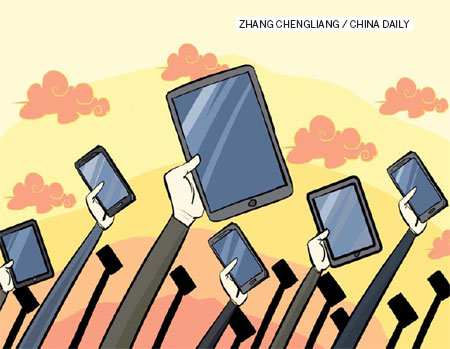In modern business, mobility is the key
Updated: 2013-07-12 08:47
By Cameron Plummer (China Daily)
|
|||||||||||


Chinese companies are enthusiastic about new technologies, but they still have lessons to learn
Mobile technologies are transforming enterprises, industries and the world.
With the surge in the use of smartphones and tablets and mobile Internet access in China overtaking the use of desktop computers, we are seeing a sea change in consumer behavior and demand in business and in social networking of how people work together.
Across the globe, market leaders are seeing mobility as something that can give them a competitive edge and that can help transform their businesses. Chinese enterprises have told me they wish to stay ahead by becoming more mobile, but how prepared are they?
To discover how Chinese companies and their global peers are dealing with the growing importance of mobility, Accenture recently conducted an online survey of more than 400 chief information officers and other IT professionals in 14 industries and 14 countries about their development and deployment of mobility solutions.
Globally, companies are all increasing their focus and spending on mobility, but Chinese enterprises are leading the world in a number of ways, in terms of their focus on: prioritizing mobile initiatives; incorporating mobility into business processes; and supporting a range of mobile devices, including bring-your-own-device options, with which Chinese employees enjoy more freedom to use their own preferred mobile devices to connect at work.
More than nine out of 10 Chinese enterprises also prefer a centralized, company-wide mobile strategy and governance to guide longer-term investment but prefer to deploy in-business units that will realize the most immediate value and demonstrate early success - for instance in sales or in the field force.
In short, Chinese enterprises are showing the highest business enthusiasm towards mobility in the world, with a strong desire to equip their workforce with mobile devices and a mobile experience that have the highest impact.
Why? The reason is historical but simple: small devices have become very, very big. The last groundswell this huge was in the late 1990s and it was called the Web. Indeed, according to our survey, 90 percent of the Chinese CIOs said that mobility would affect their business as much as or more than the Web did. The number was significantly higher than 73 percent globally.
Given the enormous market size and consumer population, Chinese enterprises cannot afford to lose the opportunity that mobility provides in the country - to increase their customer base, earn more and leapfrog their global peers. Our survey found that Chinese CIOs are keen to experiment with mobile technology to discover new solutions for customers and employees. Among them, we see a higher level of investment in trials of mobility technology in China compared with other countries on average (33 percent for China, 30 percent globally), which suggests Chinese enterprises are testing the potential benefits of increased efficiency, reduced costs, and new revenue streams.
Much more than their global peers, CIOs of Chinese business-to-consumer enterprises include targeted promotions, social sharing and access to content for consumers as features in their mobility strategies. Looking at the enterprise side, Chinese CIOs include features such as mobile-device management, collaboration and knowledge-sharing in their mobility strategies to a larger extent than the average CIO globally.
However, Chinese enterprises must overcome a number of challenges before realizing the full efficiency, cost, or revenue potential that a mobility-enabled business brings, including allocating mobility budgets to the highest-priority initiatives; deploying applications that have a big visual impact to attract and retain customers; and strengthening the governance of the mobility strategy across business units.
Companies are rightly giving priority to high-value initiatives in select functional areas. For instance, we see sales units launching tablet-based sales toolkits to unleash the sales force, or executive suites deploying mobile management dashboards. However, if attention is not focused on a unified platform to support the strategy, the value propositions of new technology adoption will slow down because of disparate tools, data repositories, and governance processes. That will mean extra costs and effort later to get the most from mobility technology and the strategic outcome.
We are also seeing the silo effect in other cases, where economics and mobility are disconnected in Chinese enterprises. Their projects aimed at reducing costs and improving efficiency remain largely traditional, and are undervaluing the additional, and sometimes substantial, supply chain, field service, and office automation benefits that can be enabled by mobile technologies.
To highlight the disparity of China versus other nations, our findings show that Chinese enterprises are lagging behind when it comes to creating customer-facing applications - those that drive revenue through customer engagement or transactions - and developing new mobility-focused marketing channels.
Of these, analytics is perhaps the most important in relation to mobility. Enterprises should apply analytics in two ways. They should track how employees and customers interact with them through their devices, and use that information to improve the design of their mobile applications. At the same time, enterprises can now collect and process massive amounts of real-time data input by employees and customers. They can use this to analyze trends and activities to improve not only business efficiency but the customer experience as well.
In the age of big data, it is remarkable that none of the Chinese CIOs consider mobile analytics a priority (compared with 11 percent globally and, for example, 30 percent in India).
Asked about key barriers or inhibitors preventing Chinese companies addressing mobile priorities, security, interoperability and cost concerns stood out. Forty-five percent of global CIOs see security as a barrier, down 5 percentage points from last year, while in China 63 percent see it as a barrier, up from 42 percent.
How can China build on its world-leading capabilities, gain a sustainable competitive edge and eventually profit financially from them? Drawing on our survey findings, I recommend four core strategies for Chinese CIOs.
First, draw on the centralized mobile strategy to take a broader view of mobility. Focus on ensuring that mobile efforts are not implemented in ways that create new silos. Creating a comprehensive mobility strategy seems to be more complex than first thought in the last year, many Chinese CIOs have told me. So they should conduct both a gap analysis and a mobile maturity assessment to identify what they need to do to catch up to peers and competitors. Mobile devices are about more than just communication; they create data that can be used to track customer preferences and develop new product and service offerings.
Second, strengthen the alignment between IT and other business units. By coordinating mobility efforts, departments can share insights in areas including developing applications, deployment, security, BYOD and managing devices. This can create greater potential for using data as more processes or mobility are enabled. Interoperability with current (legacy) systems is one major gap, while data security is the other - especially when CIOs keep an eye on BYOD. These challenges need to be addressed through cross function/unit collaboration with potential consideration of a blended BYOD/selected device strategy based on case studies of different business groups.
Third, establish a unified corporate platform to facilitate mobile analytics. Chinese companies are starting to consider that mobility is more effective when considered as part of a unified corporate platform with a flexible governance model.
Finally, build a mobile center of excellence and establish a basis for investing in and tracking mobile technologies. This will help companies invest the time to evaluate the mobility as a core enabler in broader transformations and allow them to better track the return on mobility investment, focusing on mobile usability for customers and employees alike. CIOs should establish a strong research and development group to explore new-technology options and develop a continuous flow of insight and output relating to mobile demands and capabilities. Part of this exercise should include interaction with external sources of information, including vendors in the mobile ecosystem and third-party service providers. They should also address the need to focus intensely on people and expertise.
While Chinese consumers tap and slide their touch screens for purchasing products and services online at ease, the enterprises by contrast are confronted with a lack of skill sets for developing, redefining and implementing their mobility strategy to make the sleek customer experience happen. This is an increasing concern in China, but viewed from another angle it demonstrates the huge market potential for open innovation that will combine the strengths of chief information officers, chief technology officers and external experts as their partners in the journey of transformation. As China changes gears to a consumption economy, we are seeing the beauty of business ecosystem based on mobility.
The author is managing director of Accenture Mobility, Greater China. The views do not necessarily reflect those of China Daily.
(China Daily European Weekly 07/12/2013 page10)
Today's Top News
List of approved GM food clarified
ID checks for express deliveries in Guangdong
Govt to expand elderly care
University asks freshmen to sign suicide disclaimer
Tibet gears up for new climbing season
Media asked to promote Sino-Indian ties
Shots fired at Washington Navy Yard
Minimum growth rate set at 7%
Hot Topics
Lunar probe , China growth forecasts, Emission rules get tougher, China seen through 'colored lens', International board,
Editor's Picks

|

|

|

|

|

|





